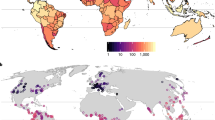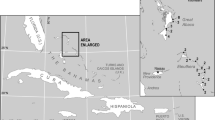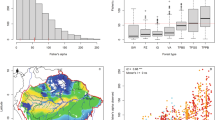Abstract
The Atlantic Forest is one of the most important biodiversity hotspots, yet only a few studies have attempted to summarize tree diversity patterns across its full extent. With the increasing availability of primary biodiversity data, such a synthesis is potentially feasible; however, a critical assessment of the available information is needed to understand the limitations of data and increase knowledge on broad-scale biodiversity patterns. Here we (i) explore the potential limitations and biases of both herbarium and inventory data, (ii) provide a synthesis of diversity patterns, and (iii) present a spatial prioritization, based on complementary scenarios, for sampling tree species across the domain. We show that despite the large amounts of herbarium data, the number of unique localities per species is rather small (median, 53) and data for most species is still scarce or not yet ready for use. The spatial patterns of both herbarium records and inventory data are influenced by the presence of protected areas, proportion of forest cover, distance to graduate programs, and variables representing ease of access. Species richness presented peaks in the mid-portion of the domain. Such a pattern is related to spatial and historical constraints, environmental variation, and influence from other phytogeographical domains.
Access this chapter
Tax calculation will be finalised at checkout
Purchases are for personal use only
Similar content being viewed by others
References
Austin MP (2002) Spatial prediction of species distribution: an interface between ecological theory and statistical modelling. Ecol Model 157:101–118
Bergamin RS, Duarte LDS, Marcilio-Silva V, Seger GDDS, Liebsch D, Marques MCM (2015) Compilation of woody species occurring in the Brazilian Atlantic Forest complex. Front Biogeogr 7:69–72
Boria RA, Olson LE, Goodman SM, Anderson RA (2014) Spatial filtering to reduce sampling bias can improve the performance of ecological niche models. Ecol Model 275:73–77
Bottin M, Peyre G, Vargas C, Raz L, Richardson JE, Sanches A (2019) Phytosociological data and herbarium collections show congruent large scale patterns but differ in their local descriptions of community composition. J Veg Sci. https://doi.org/10.1111/jvs.12825
Cain SA, Castro GMO, Pires JM, Silva NT (1956) Application of some phytosociological techniques to Brazilian rain forest. Am J Bot 43:911–941
Cantidio LS, Souza AF (2019) Aridity, soil and biome stability influence plant ecoregions in the Atlantic Forest, a biodiversity hotspot in South America. Ecography 42:1887–1898
Carnaval AC, Moritz C (2008) Historical climate modelling predicts patterns of current biodiversity in the Brazilian Atlantic Forest. J Biogeogr 35:1187–1201
Cerqueira RM, Martins FR (2015) Does climate influence spatial variation of tree species alpha diversity in the Brazilian Atlantic rainforest? Acta Sci Biol Sci 37:185–196
Cornwell WK, Pearse WD, Dalrymple RL, Zanne AE (2019) What we (don’t) know about global plant diversity. Ecography 42:1819–1831
Costa GC, Hampe A, Ledru MP et al (2018) Biome stability in South America over the last 30 kyr: inferences from long-term vegetation dynamics and habitat modelling. Glob Ecol Biogeogr 27:285–297
CRIA - Centro de Referência em Informação Ambiental (2019) SpeciesLink – Electronic Database. http://splink.cria.org.br/. Assessed 13 May 2019
Davis DE (1945) The annual cycle of plants, mosquitoes, birds, and mammals in two Brazilian forests. Ecol Monogr 15:243–295
GBIF (2016) Science review 2016. Global Biodiversity Information Facility, Copenhagen
Duarte SD, Bergamin RS, Marcilio-Silva V, Seger GDS, Marques MCM (2014) Phylobetadiversity among Forest Types in the Brazilian Atlantic Forest Complex. PLoS One 9:e105043
Eisenlohr PV, Oliveira-Filho AT (2015) Revisiting patterns of tree species composition and their driving forces in the Atlantic Forests of southeastern Brazil. Biotropica 46:689–701
Fiaschi P, Pirani JR (2009) Review of plant biogeographic studies in Brazil. J Syst Evol 47:477–496
Fundação SOS Mata Atlântica (2017) Atlas dos remanescentes florestais da Mata Atlântica – Período. Fundação SOS Mata Atlântica, INPE, São Paulo, pp 2015–2016. (Relatório técnico).
Hortal J, Bello F, Diniz-Filho JAF, Lewinsohn TM, Lobo JM, Ladle R (2015) Seven shortfalls that beset large-scale knowledge of biodiversity. Annu Rev Ecol Evol Syst 46:523–549
Lima RAF, Mori DP, Pita G et al (2015) How much do we know about the endangered Atlantic Forest? Reviewing nearly 70 years of information on tree community surveys. Biodivers Conserv 24:2135–2148
Maia FR, Zwiener VP, Morokawa R, Silva-Pereira V, Goldenberg R (2017) Phylogeography and ecological niche modelling uncover the evolutionary history of Tibouchina hatschbachii (Melastomataceae), a taxon restricted to the subtropical grasslands of South America. Bot J Linn Soc 183:616–632
Marcilio-Silva V, Zwiener VP, Marques MCM (2017) Metacommunity structure, additive partitioning and environmental drivers of woody plants diversity in the Brazilian Atlantic Forest. Divers Distrib 23:1110–1119
Marques MCM, Swaine MD, Liebsch D (2011) Diversity distribution and floristic differentiation of the coastal lowland vegetation: implications for the conservation of the Brazilian Atlantic Forest. Biodivers Conserv 20:153–168
Moilanen A, Pouzols FM, Meller L, Veach V, Arponen A, Leppänen J, Kujala H (2014) Zonation –Spatial conservation planning methods and software. Version 4. User Manual. University of Helsinki, Finland
Mori SA, Boom BA, Prance GT (1981) Distribution patterns and conservation of eastern Brazilian coastal forest tree species. Brittonia 33:233–245
Murray-Smith C, Brummitt NA, Oliveira-Filho AT, Bachman S, Moat J, Lughadha EMN, Lucas EJ (2009) Plant diversity hotspots in the Atlantic coastal forests of Brazil. Conserv Biol 23:151–163
Neves DM, Dexter KG, Pennington RT et al (2017) Dissecting a biodiversity hotspot: the importance of environmentally marginal habitats in the Atlantic Forest domain of South America. Divers Distrib 23:8989–8909
Oliveira U, Paglia AP, Brescovit AD et al (2016) The strong influence of collection bias on biodiversity knowledge shortfalls of Brazilian terrestrial biodiversity. Divers Distrib 22:1232–1244
Oliveira U, Brescovit AD, Santos AJ (2017) Sampling effort and species richness assessment: a case study on Brazilian spiders. Biodivers Conserv 26:1481–1493
Oliveira-Filho AT (2017). NeoTropTree, Flora arbórea da Região Neotropical: Um banco de dados envolvendo biogeografia, diversidade e conservação. Universidade Federal de Minas Gerais. Retrieved from http://www.neotroptree.info
Oliveira-Filho AT, Budke JC, Jarenkow JA, Eisenlohr PV, Neves DM (2013) Delving into the variations in tree species composition and richness across South American subtropical Atlantic and Pampean forests. J Plant Ecol 8:242–260
Oliveira-Filho AT, Fontes MAL (2000) Patterns of floristic differentiation among Atlantic Forests in southeastern Brazil, and the influence of climate. Biotropica 32:793–810
Oliveira-Filho AT, Ratter JA (1994) Database: Woody flora of 106 forest areas of eastern tropical South America. Royal Botanic Garden, Edinburgh
Peterson AT, Asase A, Canhos DAL, de Souza S, Wieczorek J (2018) Data leakage and loss in biodiversity informatics. Biodivers Data J 6:e26826
Plataforma Sucupira (2019) Cursos recomendados e reconhecidos. Área de Ensino. https://www.sucupira.capes.gov.br/sucupira/. Assessed 12 Jan 2019
R Core Team (2018) R: A language and environment for statistical computing. R Foundation for Statistical Computing, Vienna, Austria
REFLORA – Plantas do Brasil: Resgate Histórico e Herbário Virtual para o Conhecimento e Conservação da Flora Brasileira (2019). http://reflora.jbrj.gov.br/reflora/PrincipalUC/PrincipalUC.do. Assessed 14 Nov 2019
Rezende VL, Miranda PLS, Meyer L et al (2015) Tree species composition and richness along altitudinal gradients as a tool for conservation decisions: the case of Atlantic semideciduous forest. Biodivers Conserv 24:2149–2163
Rezende VL, Bueno ML, Eisenlohr PV, Oliveira-Filho AT (2018) Patterns of tree species variation across southern South America are shaped by environmental factors and historical processes. Perspect Plant Ecol Evol Syst 34:10–16
Sánchez-Tapia A, Garbin ML, Siqueira MF, Guidoni-Martins KG, Scarano FR, Carrijo TT (2018) Environmental and geographical space partitioning between core and peripheral Myrsine species (Primulaceae) of the Brazilian Atlantic Forest. Bot J Linn Soc 187:633–652
SanMartín I, Ronquist F (2004) Southern Hemisphere biogeography inferred by event-based models: plant versus animal patterns. Syst Biol 53:216–243
Sheth SN, Lohmann LG, Consiglio T, Jiménez I (2008) Effects of detectability on estimates of geographic range size in Bignonieae. Conserv Biol 22:200–211
Silva LAE, Fraga CN, Almeida TMH et al (2017) Jabot – Sistema de Gerenciamento de Coleções Botânicas: a experiência de uma década de desenvolvimento e avanços. Rodriguésia 68:391–410
Sousa-Baena MS, Garcia LC, Peterson AT (2013) Completeness of digital accessible knowledge of the plants of Brazil and priorities for survey and inventory. Divers Distrib 20:369–381
Veloso HP (1945) As comunidades e estações botânicas de Teresópolis, Estado do Rio de Janeiro (com um ensaio de chave dendrológica). Bol Mus Nac 3:1–95
Veloso HP (1946) A vegetação do município de Ilhéus, Estado da Bahia, I—Estudo sinecológico das áreas de pesquisas sobre a febre amarela silvestre realizado pelo SEPFA. Mem Inst Oswaldo Cruz 44:13–103
Veloso HP, Klein RM (1957) As comunidades e associações vegetais da mata pluvial do sul do Brasil I. As comunidades do município de Brusque, Estado de Santa Catarina. Sellowia 8:81–235
Veloso HP, Klein RM (1968) As comunidades e associações vegetais da mata pluvial do sul do Brasil VI. Agrupamentos arbóreos dos contra-fortes da Serra Geral situados ao sul da costa catarinense e ao norte da costa sul-riograndense. Sellowia 20:127–180
Vibrans AC, Gasper AL, Müller JJ, Mantovani A, Aguilar MD, Marschalek R (2015) Inventário florístico florestal de Santa Catarina. FURB, Blumenau
Yang W, Ma K, Kreft H (2013) Geographical sampling bias in a large distributional database and its effects on species richness-environment models. J Biogeogr 40:1415–1426
Werneck MDS, Sobral MEG, Rocha CTV, Landau EC, Stehmann JR (2011) Distribution and endemism of angiosperms in the Atlantic Forest. Nat Conservacao 9:188–193
Zappi C, Filardi FLR, Leitman P et al (2015) Growing knowledge: an overview of Seed Plant diversity in Brazil. Rodrigésia 66:1085–1113
Zeileis A, Kleiber C, Jackman S (2008) Regression models for count data in R. J Stat Softw 27(8). http://www.jstatsoft.org/v27/i08/
Zuur AF, Ieno EN, Walker NJ, Saveliev AA, Smith GM (2009) Mixed effects models and extensions in ecology with R. Springer, New York
Zwiener VP, Padial AA, Marques MCM, Faleiro FV, Loyola R, Peterson AT (2017) Planning for conservation and restoration under climate and land use change in the Brazilian Atlantic Forest. Divers Distrib 23:955–966
Zwiener VP, Lira-Noriega A, Grady CJ, Padial AA, Vitule JRS (2018) Climate change as a driver of biotic homogenization of woody plants in the Atlantic Forest. Glob Ecol Biogeogr 27:298–309
Zwiener VP, Padial AA, Marques MCM (2020) The mechanisms explaining tree species richness and composition are convergent in a megadiverse hotspot. Biodivers Conserv 29:799–815
Author information
Authors and Affiliations
Editor information
Editors and Affiliations
Rights and permissions
Copyright information
© 2021 Springer Nature Switzerland AG
About this chapter
Cite this chapter
Zwiener, V.P., de Lima, R.A.F., Sánchez-Tapia, A., Rocha, D.S.B., Marques, M.C.M. (2021). Tree Diversity in the Brazilian Atlantic Forest: Biases and General Patterns Using Different Sources of Information. In: Marques, M.C.M., Grelle, C.E.V. (eds) The Atlantic Forest. Springer, Cham. https://doi.org/10.1007/978-3-030-55322-7_6
Download citation
DOI: https://doi.org/10.1007/978-3-030-55322-7_6
Published:
Publisher Name: Springer, Cham
Print ISBN: 978-3-030-55321-0
Online ISBN: 978-3-030-55322-7
eBook Packages: Biomedical and Life SciencesBiomedical and Life Sciences (R0)




